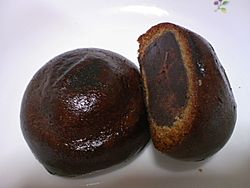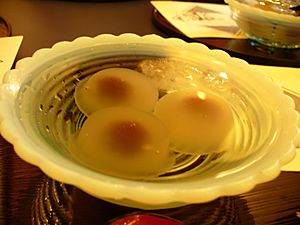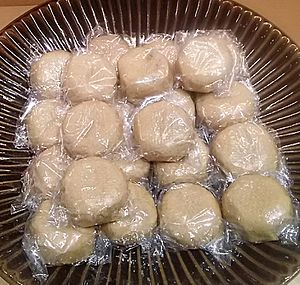Manjū facts for kids
 |
|
| Type | Wagashi |
|---|---|
| Place of origin | Japan |
| Region or state | East Asia |
| Main ingredients | Flour, rice powder, buckwheat, red bean paste |
Manjū (饅頭, まんじゅう) is a traditional Japanese sweet treat. It's a type of wagashi, which means a Japanese dessert.
Most manjū have a soft outer layer. This outer part is often made from flour, rice powder, or buckwheat. Inside, they are usually filled with anko, a sweet paste. This paste is typically made from boiled adzuki beans and sugar.
Sometimes, you might find manjū with other yummy fillings. These can include things like chestnut jam. In Hawaii, some manjū are made with a filling of purple sweet potato, butter, milk, sugar, and salt. But the most common filling is still the bean paste. There are different kinds of bean paste, such as koshian and tsubuan.
History of Manjū
Manjū is a traditional Japanese pastry. It is made with flour, unlike mochi which uses rice.
This sweet treat first came from China. In China, it was known as mantou. In 1341, a Japanese traveler returned from China. He brought mantou with him to Japan. He then started selling it as nara-manjū. This is how Japanese manjū began.
People in Japan have been eating manjū for almost 700 years. Today, you can find it in many Japanese sweet shops. It is a popular snack because it is usually not expensive.
Different Kinds of Manjū
There are many different types of manjū. Some kinds are more common than others.
- Matcha Manjū: This is a very common type. The outside of this manjū has a green tea flavor. It is also colored green, just like green tea!
- Mizu Manjū: People traditionally eat mizu manjū in the summer. It has a flavored bean filling inside. The outside of mizu manjū is made with kuzu starch. This makes the dough look clear and jelly-like.
- Other Fillings: Manjū can also have many different flavored fillings. For example, you might find some with orange-flavored cream.
- Regional Manjū: Just like many Japanese foods, some manjū are special to certain areas. For example, in Hiroshima and Miyajima, you can find momiji manjū. These are shaped like maple leaves! In the Saitama area, there is a special manjū called Jumangoku manjū.
See also
 In Spanish: Manjū para niños
In Spanish: Manjū para niños



